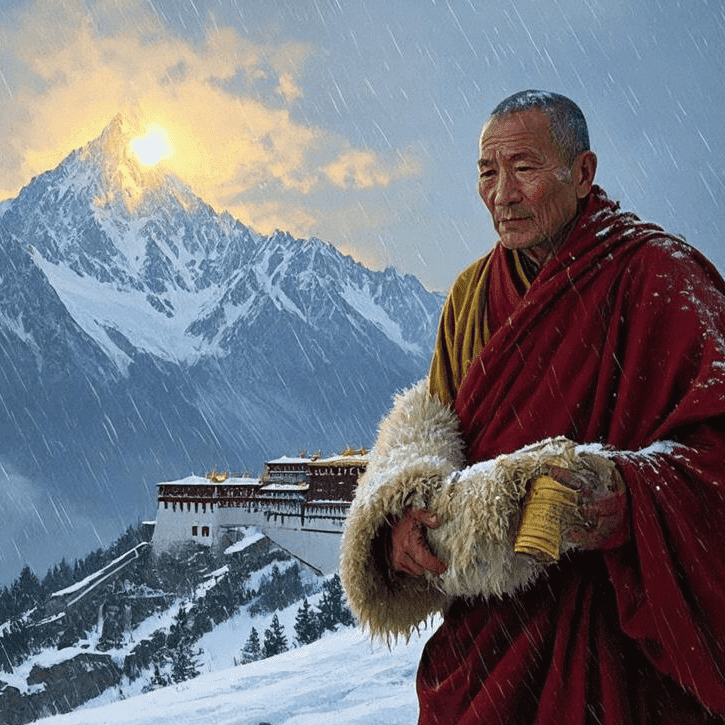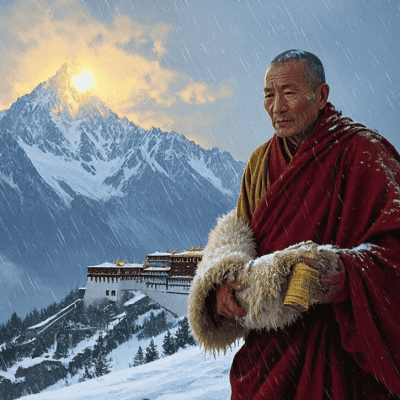Tibetan Buddhism: The Ancient Himalayan Wisdom Lighting Up Modern Oriental Design

Imagine: Seventh-century Tibet. An Indian monk braves the Himalayan blizzards, his maroon robes whipping against the wind as he shelters sutras wrapped in yak leather. Against impossible odds—thin air, frozen earth—an extraordinary spiritual legacy took root: Tibetan Buddhism.
This was never merely a religion. It became a living tapestry woven with mythology, philosophy, sacred art, and cosmic rituals—a civilization forged at the rooftop of the world. Today, fragments of this high-altitude wisdom whisper through globally cherished designs: a turquoise-inlaid ring echoing ancient blessings, a silk scarf blazing with Thangka-inspired hues, or a meditation space centered around a Mandala-shaped lamp. These are keys to unlocking 1,300 years of symbolic storytelling, invitations to an enigmatic Eastern aesthetic.

The Princess & The Pilgrim
Tibetan Buddhism’s genesis centers on an imperial marriage. When Princess Wencheng of China’s Tang Dynasty arrived in Tibet circa 641 CE, her dowry included a revered treasure: a golden Buddha statue purportedly blessed by Siddhartha Gautama himself (today enshrined in Lhasa’s Jokhang Temple). King Songtsen Gampo—strategist and visionary—saw Buddhism not just as faith, but as a cultural catalyst. His construction of Lhasa’s first temples marked Buddhism’s formal arrival.
Clash and Harmony: Buddhism Meets Bon
Yet Tibet’s indigenous Bon tradition—an earth-centered practice worshiping nature spirits—resisted this foreign philosophy. The struggle lasted centuries:
-
Bon Adopted: Buddhism absorbed Bon’s mountain deities into its pantheon (e.g., deity Nyenchen Tanglha became a protector).
-
Innovative Synthesis: Unique Tibetan solutions emerged, like the tulkusystem—reincarnating lamas—an institution absent in other Buddhist traditions.
-
Tantric Infusion: Post-10th century “Later Diffusion” era saw esoteric masters like Atiśa arrive from India, embedding complex Vajrayana rituals into Tibetan practice.

From the high plateau, distinct spiritual lineages evolved:
School |
Tibetan Name |
Distinctive Features |
Key Symbols |
Nyingma |
རྙིང་མ། |
Oldest school; emphasizes Dzogchen meditation; rituals with drums/skulls |
Rainbow Light imagery |
Kagyu |
བཀའ་བརྒྱུད། |
“Whispered Transmission”; ascetic yogis like Milarepa; focus on mastery |
White scarves, Mahamudra |
Sakya |
ས་སྐྱ་། |
Scholastic rigor; monastic rule; red/white/grey temple walls |
Wisdom sword, Mandala |
Gelug |
དགེ་ལུགས་པ། |
Founded by Tsongkhapa; discipline/study focus; Dalai Lama lineage |
Yellow hats, Vajra |
Beyond prayer, Tibetan Buddhism became an aesthetic revolution crystallizing cosmic ideas:
-
Thangka Painting: Sacred scrolls mapping spiritual concepts using crushed gem pigments and gold. Each color carries meaning (gold=enlightenment, red=compassion).
-
Mandala Sand Art: Geometric diagrams embodying the universe—meticulously laid with dyed sand. Their destruction teaches impermanence.
-
Sound Alchemy: Ritual implements produce resonant codes: Dungchenhorns summon deities, paired Dorje & Bell symbolize wisdom/method.
-
Prayer Wheels & Flags: Mechanical mantras spinning “Om Mani Padme Hum” (Hail, Jewel in the Lotus!) on wheels, or prayers printed on wind-scattered flags.

This heritage now fuels a new wave of Eastern elegance:
Cultural Keys in Modern Objects:
-
Jewelry: Turquoise rings channeling sky deities’ protection, coral beads invoking vitality
-
Home Decor: Laser-cut metal Mandalas casting sacred shadows, diffusers shaped like ritual butter lamps
-
Fashion: Gradient shawls dyed with prayer flag palettes, asymmetric jewelry embedding Dharma Wheel motifs
-
Wellness: Meditation soundtracks woven with monastic chants and Himalayan singing bowls
Why Embrace These Designs?
-
Possess Living Mythology: Each piece carries DNA from ancient visual narratives—not just decoration.
-
Embody Sacred Harmony: Mandalas’ geometry channels focus; Thangka hues radiate calm.
-
Honor Craft Renaissance: Support artisans merging ancestral techniques with modern ethics.




This Mandala-inspired meditation lamp has transformed my space into a Himalayan sanctuary. When lit, its laser-cut patterns cast sacred geometry across my walls – suddenly Xuanzang’s perilous pilgrimages feel present in the dancing shadows. Holding it, I’m awestruck by how modern designers channel ancient thangka wisdom: the cobalt blues mirroring celestial deities, crimson accents echoing monastic robes.
The blog’s tales of Princess Wencheng’s golden Buddha gave me chills. My turquoise-inlaid ring now feels like carrying her diplomatic courage – its protective Bon-po symbolism reimagined for city life. Every detail whispers lineage: the oxidized silver recalls ritual dorjes, while the gradient scarf blends prayer flag hues with Parisian elegance.
Craftsmanship honors tradition. The lamp’s brass base bears mantra engravings visible only when lit – a hidden devotion echoing sand mandalas’ transient beauty. My singing bowl? Forged by Nepali artisans using 8th-century alloy ratios.
More than decor, these pieces are mindfulness tools. Rotating the ring centers me during stress; the scarf’s silk recalls monk robes’ humility. They spark conversations about Tsongkhapa’s reforms and Milarepa’s poetry.
For seekers of beauty with soul: this collection bridges cliffside monasteries and modern living. You’re not buying objects – you’re preserving a civilization that turned thin air into spiritual gold.